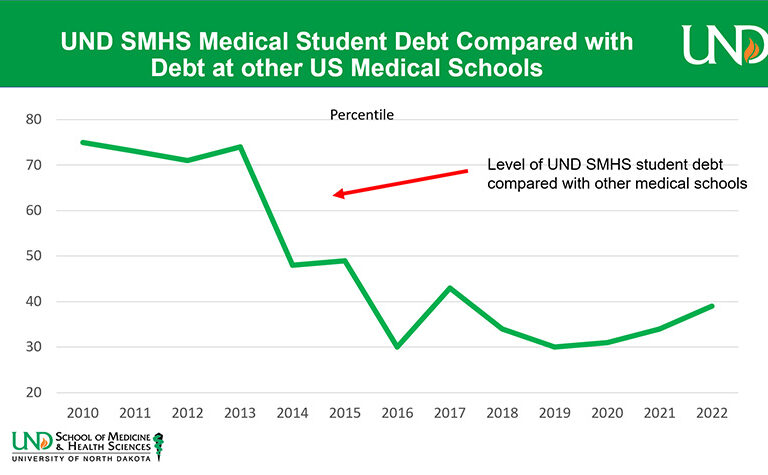From the Dean: Our four likely COVID-19 outcomes
 As UND faculty, my wife Dr. Susan Farkas and I had the opportunity to undergo COVID-19 testing before the start of classes this past Sunday during the screening event sponsored through NDSU and held in the Fargodome parking lot near our home in Fargo. We had pre-registered online and the entire process was slick, quick, and uneventful—the folks doing these screenings certainly have been able to expedite the process as they’ve worked their way through a broadened schedule of such events. We remained in our vehicle and only had to roll the windows down to get tested. Although we had nasal swabs done, the experience was not too unpleasant–although for a few seconds it felt a little weird, with a modest burning in the back of my nasal passages. The entire swabbing process took only about seven seconds, and we had no after-effects. Best of all, from the time we drove into the testing site until we were on our way home was probably under 10 minutes–with screening of us both. And we got our negative (yeah!) test results in about a day. Thanks to everyone who made this and other screenings across the state so uneventful, relatively speaking. We certainly have no hesitation about returning for repeat testing as might be indicated.
As UND faculty, my wife Dr. Susan Farkas and I had the opportunity to undergo COVID-19 testing before the start of classes this past Sunday during the screening event sponsored through NDSU and held in the Fargodome parking lot near our home in Fargo. We had pre-registered online and the entire process was slick, quick, and uneventful—the folks doing these screenings certainly have been able to expedite the process as they’ve worked their way through a broadened schedule of such events. We remained in our vehicle and only had to roll the windows down to get tested. Although we had nasal swabs done, the experience was not too unpleasant–although for a few seconds it felt a little weird, with a modest burning in the back of my nasal passages. The entire swabbing process took only about seven seconds, and we had no after-effects. Best of all, from the time we drove into the testing site until we were on our way home was probably under 10 minutes–with screening of us both. And we got our negative (yeah!) test results in about a day. Thanks to everyone who made this and other screenings across the state so uneventful, relatively speaking. We certainly have no hesitation about returning for repeat testing as might be indicated.
Since I spend a lot of my time dealing with COVID-related issues, here’s an update on the pandemic and especially its impact here in North Dakota. By the way, these bullet points come from a summary document I prepare every two weeks for the North Dakota University System:
- Since the start of the pandemic, just over 1 in 100 North Dakotans (1.4%) have been documented to have been infected. It has been estimated that the true frequency of infection is 10-fold higher so that would translate into around 14% of the population in North Dakota.
- At least one-third (and maybe as many as almost one-half) of patients are asymptomatic, at least when they first are capable of spreading the disease. Thus, relying on self-reported symptoms, temperature checks, and so on, will not identify many of the spreaders.
- All of North Dakota’s 53 counties have had cases.
- The current (and ongoing) major outbreak is in Burleigh/Morton counties with about 32% of the active cases, but only 17% of the population of North Dakota.
- A second current “hot spot” is right here in Grand Forks County, with activity related to the UND campus.
- The overall mortality rate in North Dakota is about 1.3% and is much higher for the elderly and those with underlying health conditions. This contrasts with the mortality of influenza, which is 10 to 15 times less (around 0.1%)
- The effective duration of infectivity probably is fewer than 10 days.
To see the latest data, you can see dashboards for North Dakota here and UND here.
Since we all are experiencing some degree of COVID-19 fatigue, perhaps the most pressing question is, “When and how will the pandemic end?” There really only are four conceivable end-games:
- The virus mutates into a more benign variant, but there is no suggestion that coronaviruses do this in a major way. Thus, this is unlikely.
- Effective medical treatments are developed that lessen the severity of the infection, and there certainly have been some encouraging developments in this regard.
- Herd immunity develops (to achieve this protection of the community, it probably requires about two-thirds of the population to be infected). Please note though that this would be a very bad outcome with a disease that has a 1.3 % mortality rate, as it would translate into almost 7,000 COVID-19 deaths in North Dakota, whereas currently we have “only” around 140.
- An effective vaccine is developed and widely deployed. This is the best long-term option by far, so stay tuned!
Until we reach that resolution or combination of resolutions, however, I would encourage each of you to remain vigilant and consistent in the use of physical distancing, hand-washing, masking-up on or off campus, and getting tested as appropriate. We collectively are a community that cares for one another, and we are in this together. We all need to do our part to keep our community as safe as possible.
Joshua Wynne, MD, MBA, MPH
Vice President for Health Affairs, UND
Dean, UND School of Medicine & Health Sciences


